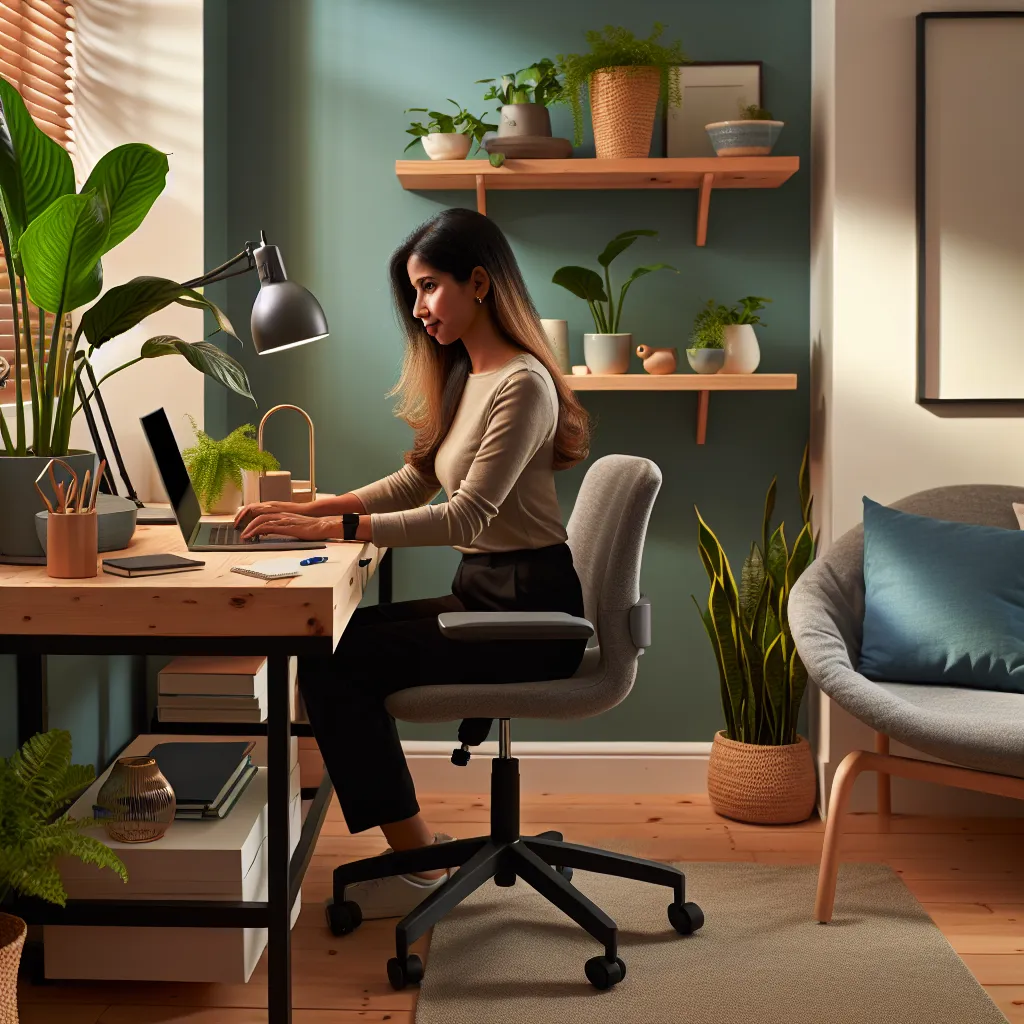Are you preparing for the IELTS Speaking test and wondering how to tackle the topic “Describe a time when you set up a home office”? This comprehensive guide will provide you with valuable insights, sample answers, and expert tips to help you excel in this part of the exam. As an experienced IELTS examiner, I’ll walk you through each section of the speaking test, focusing on this particular topic.
Nội dung bài viết
- Part 1: Introduction and Interview
- Sample Question 1: Do you prefer working from home or in an office?
- Sample Question 2: What do you think are the essential items for a home office?
- Part 2: Long Turn (Cue Card)
- Cue Card
- Sample Answer (Band 8-9)
- Follow-up Questions
- Part 3: Two-way Discussion
- Question 1: How do you think the trend of working from home will impact office spaces in the future?
- Question 2: What are some potential drawbacks of widespread adoption of remote work?
- Key Vocabulary and Phrases for High Scores
- Tips from an IELTS Examiner
 Home office setup
Home office setup
Part 1: Introduction and Interview
In this section, the examiner may ask you some general questions about your work or study environment. Here are some potential questions and sample answers:
Sample Question 1: Do you prefer working from home or in an office?
Band 6-7 Answer:
“I think both have their advantages. Working from home is convenient and saves time on commuting, but working in an office allows for better collaboration with colleagues.”
Band 8-9 Answer:
“That’s an interesting question. I believe there are merits to both options. Working from home offers unparalleled flexibility and eliminates commute time, which can significantly boost productivity. However, the office environment fosters face-to-face interactions and spontaneous brainstorming sessions, which are crucial for team dynamics and creativity. Personally, I prefer a hybrid model that combines the best of both worlds.”
Sample Question 2: What do you think are the essential items for a home office?
Band 6-7 Answer:
“I think a comfortable chair, a good desk, and a reliable computer are the most important things for a home office. Good lighting is also necessary.”
Band 8-9 Answer:
“In my opinion, the cornerstone of an effective home office is ergonomic furniture, particularly a supportive chair and an adjustable desk to promote proper posture and reduce fatigue. A high-performance computer or laptop is indispensable for most professional tasks. Additionally, I believe adequate lighting is crucial, preferably a combination of natural light and adjustable artificial lighting to reduce eye strain. Lastly, a noise-cancelling headset can be invaluable for maintaining focus and professional communication in video calls.”
Part 2: Long Turn (Cue Card)
In this section, you’ll be given a cue card with a topic and some bullet points. You’ll have one minute to prepare, then you should speak for 1-2 minutes on the topic. Here’s a sample cue card related to setting up a home office:
Cue Card
Describe a time when you set up a home office.
You should say:
- When and where you set it up
- Why you needed to set up a home office
- What items you included in your home office
- And explain how you felt about working from your home office
Sample Answer (Band 8-9)
“I’d like to talk about the time I set up my home office, which was in March 2020, right at the onset of the COVID-19 pandemic. As the world was grappling with unprecedented changes, my company decided to implement a remote work policy to ensure employee safety.
I chose to convert a spare room in my apartment into a dedicated workspace. This room, previously used for storage, was perfect because it offered ample natural light and was relatively quiet, being at the back of the apartment.
The primary motivation behind setting up this home office was to create a professional environment that would enable me to maintain my productivity and work-life balance during the lockdown. I realized that working from my dining table or sofa wouldn’t be sustainable in the long run, and I needed a space that would help me mentally transition into ‘work mode’.
In terms of essential items, I invested in an ergonomic chair to support my posture during long work hours. I also purchased a spacious desk that could accommodate my laptop, an external monitor for enhanced productivity, and some storage space for documents. To improve the aesthetics and ambiance of the room, I added some potted plants and inspiring artwork. I made sure to have good lighting, including a desk lamp for those late-night work sessions.
Initially, I felt a bit apprehensive about working from home full-time. However, as I settled into my new routine, I began to appreciate the flexibility and comfort of my home office. The ability to customize my workspace to my exact preferences was incredibly satisfying. Moreover, the time saved from commuting allowed me to strike a better work-life balance, giving me more time for personal pursuits and family.
In retrospect, setting up this home office was a transformative experience. It not only helped me navigate the challenges of remote work during a global crisis but also taught me valuable lessons about self-discipline, time management, and the importance of creating a conducive work environment, regardless of the location.”
Follow-up Questions
- How has your home office setup changed since you first created it?
Band 8-9 Answer:
“Since its inception, my home office has undergone several iterations to optimize both comfort and productivity. I’ve fine-tuned the ergonomics by investing in a standing desk, allowing me to alternate between sitting and standing throughout the day. This has significantly improved my physical well-being and energy levels. I’ve also upgraded my technology, adding a high-quality webcam and microphone to enhance my virtual communication capabilities. Furthermore, I’ve experimented with various organizational systems to keep my workspace clutter-free and efficient, which has had a positive impact on my focus and workflow.”
- What advice would you give to someone setting up a home office for the first time?
Band 8-9 Answer:
“For someone embarking on their home office journey, I would emphasize the importance of ergonomics above all else. Investing in a good chair and desk can prevent long-term health issues and boost productivity. Secondly, I’d advise them to create a dedicated workspace, separate from living areas if possible, to maintain a clear boundary between work and personal life. It’s also crucial to ensure adequate lighting and to personalize the space with elements that inspire creativity and focus. Lastly, I’d recommend regularly reassessing and adjusting the setup based on personal needs and work requirements, as creating an ideal home office is often an evolving process.”
Part 3: Two-way Discussion
In this section, the examiner will ask you more abstract questions related to the topic. Here are some sample questions and answers:
Question 1: How do you think the trend of working from home will impact office spaces in the future?
Band 6-7 Answer:
“I think more companies will offer flexible work options, and this might lead to smaller office spaces. Companies might use hot-desking systems where employees share desks.”
Band 8-9 Answer:
“The shift towards remote work is likely to have a profound impact on traditional office spaces. We’re already seeing a trend towards more flexible and collaborative environments rather than rows of individual cubicles. I anticipate that companies will downsize their physical office footprint, opting instead for smaller, more versatile spaces that facilitate team meetings, brainstorming sessions, and social interactions. The concept of hot-desking or hot-seating may become more prevalent, with employees reserving workspaces as needed rather than having assigned desks. Additionally, we might see an increase in satellite offices or co-working spaces in suburban areas to accommodate employees who prefer a hybrid work model. This evolution could lead to significant changes in urban planning and commercial real estate markets.”
Question 2: What are some potential drawbacks of widespread adoption of remote work?
Band 6-7 Answer:
“Some problems could be difficulty in separating work and personal life, and less communication between team members. It might also be harder for new employees to learn from more experienced colleagues.”
Band 8-9 Answer:
“While remote work offers numerous benefits, its widespread adoption could present several challenges. One significant concern is the potential for social isolation and its impact on mental health. The lack of face-to-face interactions might lead to feelings of disconnection and loneliness among employees. Another crucial issue is the blurring of boundaries between work and personal life, which could result in burnout if not managed properly. From an organizational perspective, maintaining company culture and fostering innovation might become more challenging without regular in-person collaborations. Additionally, there’s the risk of creating a two-tier workforce – those who can work remotely and those who can’t, potentially leading to inequalities. Lastly, cybersecurity becomes a more pressing concern as sensitive company data is accessed from various locations and networks.”
Key Vocabulary and Phrases for High Scores
To achieve a high band score in your IELTS Speaking test, it’s crucial to use a range of sophisticated vocabulary and complex sentence structures. Here are some key terms and phrases related to the topic of setting up a home office:
-
Ergonomic (adjective) /ˌɜːrɡəˈnɒmɪk/ – designed for efficiency and comfort in the working environment
Example: “I invested in an ergonomic chair to support my back during long work hours.” -
Productivity (noun) /ˌprɒdʌkˈtɪvəti/ – the effectiveness of productive effort
Example: “Setting up a dedicated home office significantly boosted my productivity.” -
Work-life balance (noun phrase) /wɜːrk laɪf ˈbæləns/ – the division of one’s time and focus between working and family or leisure activities
Example: “Working from home allowed me to achieve a better work-life balance.” -
Customizable (adjective) /ˈkʌstəmaɪzəbl/ – able to be modified to suit individual requirements
Example: “One advantage of a home office is that it’s fully customizable to your preferences.” -
Conducive (adjective) /kənˈdjuːsɪv/ – making a certain situation or outcome likely or possible
Example: “I aimed to create an environment conducive to focus and creativity.”
Tips from an IELTS Examiner
As an experienced IELTS examiner, I recommend the following strategies to excel in the Speaking test:
-
Practice regularly: Engage in daily speaking practice, focusing on a variety of topics.
-
Expand your vocabulary: Learn new words and phrases related to work, technology, and modern lifestyles.
-
Use complex structures: Incorporate a mix of simple and complex sentences in your responses.
-
Develop your ideas: Don’t just answer questions briefly. Expand on your thoughts and provide examples.
-
Stay calm and confident: Remember, the examiner is there to assess your English, not to trick you.
By following these guidelines and practicing regularly, you’ll be well-prepared to tackle any question about setting up a home office or related topics in your IELTS Speaking test. Good luck with your preparation!
For more tips on maintaining work-life balance in remote jobs, check out our article on challenges of maintaining work-life balance in remote jobs. Additionally, if you’re interested in creating a stress-free home environment, which is crucial for an effective home office, don’t miss our guide on how to create a stress-free home environment.


